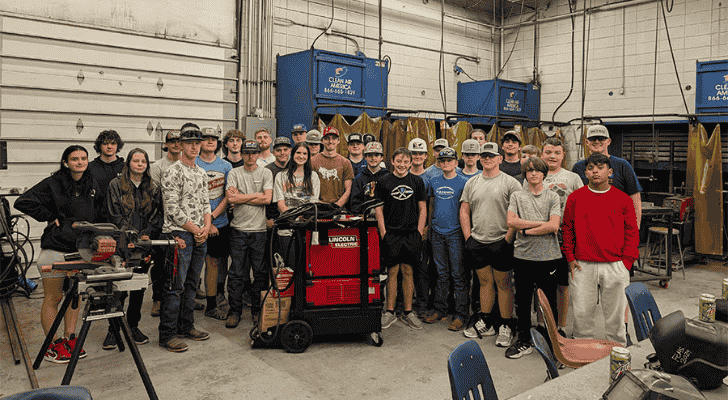Weld Your Future: Paid Welder Training Programs Can Help You Earn While You Learn
Looking for a stable, high-paying welding career in 2025? Paid training programs offered by the U.S. government and non-profits are your ideal choice. These 1-4 year programs allow you to earn while you learn diverse welding skills, leading to potential annual salaries of $40,000-$70,000 upon graduation. Regardless of age or background, seize this opportunity and launch your welding career now!

1. Government-Supported Paid Training: Learn and Earn Simultaneously
One of the most attractive aspects of government-supported welding training in 2025 is the opportunity to earn while you learn. Programs such as those offered by the U.S. Department of Labor and local state initiatives combine on-the-job training with classroom education, allowing students to gain practical experience while earning a wage.
Time Commitment: These programs typically last between 1 to 4 years, depending on the intensity of the program and your prior experience. The duration provides enough time for welders to master a variety of welding techniques.
Earnings During Training: Students in government-supported apprenticeships generally start earning a salary as soon as they begin their training. These wages can increase over time as the trainee gains more experience, with average starting salaries between $15 and $20 per hour.
2. Training Options for All Ages
Welding training is available for people of all ages, with different programs targeting specific age groups.
Young Adults (18-24): Many young people enter welding apprenticeships straight out of high school or after completing their GED. These programs are tailored to help them quickly gain job-specific skills.
Mid-Career Professionals (25-40): Adults looking to transition careers often benefit from welding training programs, which offer accelerated learning and certification tracks.
Older Adults (40+): It’s never too late to become a welder. Many programs cater to older adults seeking to re-enter the workforce or take on new skills for a second career.

3. What You’ll Learn: Skills for the Future
Welding training programs teach a range of skills that are in high demand across industries such as manufacturing, construction, and energy. Here are some key skills you will develop:
Welding Techniques: From basic arc welding to advanced techniques like TIG and MIG welding, training programs ensure that you are proficient in various welding methods.
Blueprint Reading: Understanding and interpreting blueprints and technical drawings is essential for any welder.
Safety Practices: A large part of welding training involves learning how to safely operate welding equipment and handle potentially hazardous materials.
Problem Solving: Welders are often required to troubleshoot and solve technical issues on the job, making critical thinking a key aspect of training.
4. The Benefits of Completing a Paid Training Program
Upon completion of a welding training program, you will not only have the confidence of having learned a valuable trade but also:
Earn a Competitive Salary: Skilled welders can expect to earn between $40,000 to $70,000 per year, depending on their experience and location.
Job Security: Welders are in high demand across many industries, meaning job opportunities are plentiful.
Certification: Completing a recognized apprenticeship or certification program opens doors to higher-paying positions and the potential for career advancement.
6. How to Apply: Step-by-Step Process
Here’s how you can apply for a welding paid training program:
Research Available Programs: Start by looking into programs offered by the U.S. Department of Labor and local community colleges. Check out non-profit organizations like Helmets to Hardhats or The American Welding Society for additional opportunities.
Meet Eligibility Requirements: While most programs don’t require prior experience, applicants must meet basic educational and age requirements.
Submit Your Application: Submit your application directly to the apprenticeship program or through your local training center. Include your resume, any relevant certifications, and a letter of interest.
Interview and Selection: Many programs require an interview or assessment to ensure you are committed and capable of completing the program.
Start Training: Once accepted, you will begin your hands-on training with a employer and attend classroom sessions to complement your learning.
5. Real-Life Success Stories
John’s Journey: John, a 32-year-old former truck driver from Pennsylvania, decided to take up welding after participating in a Department of Labor apprenticeship. Within two years, he transitioned into a full-time welding role with General Electric earning a salary of $55,000 per year.
Maria’s Shift: Maria, a mother of two in her 40s, joined a non-profit welding training program in Texas after being laid off from a retail job. After completing her program, Maria was hired by a local manufacturing plant and now enjoys a stable job with a starting wage of $18 per hour, with the potential for raises as she gains experience.

7. Conclusion: Take the First Step Toward a Rewarding Career in Welding
Welding is an incredible opportunity for anyone looking to start a new career in 2025. With government-supported and non-profit programs offering paid training, you can develop a sought-after skill while earning an income. Whether you are transitioning careers or just starting out, welding can provide you with stability, job security, and a competitive salary.
📌 Don’t miss out on these training programs that allow you to learn while you earn. Apply now to begin your journey toward a rewarding career in welding!
For more information, visit the following links:
- U.S. Department of Labor: ApprenticeshipUSA
- Helmets to Hardhats: www.helmetstohardhats.org
- American Welding Society: www.aws.org
